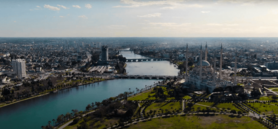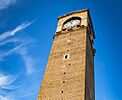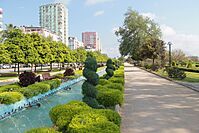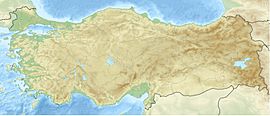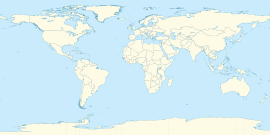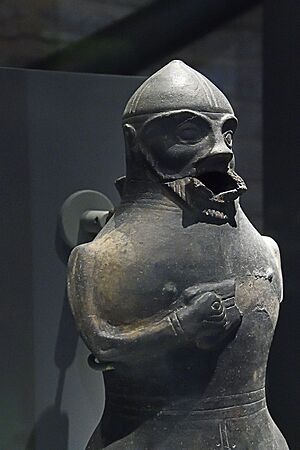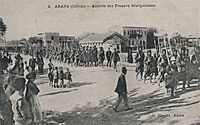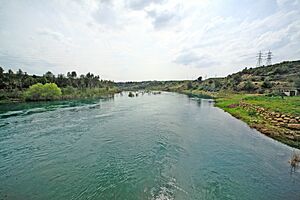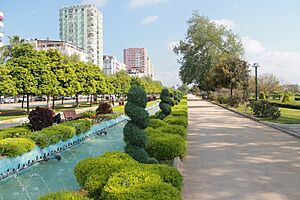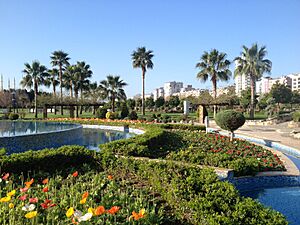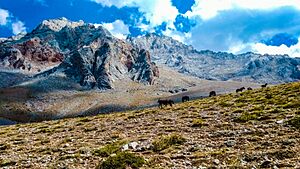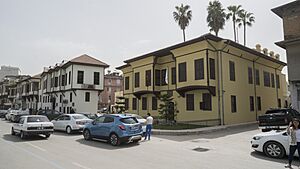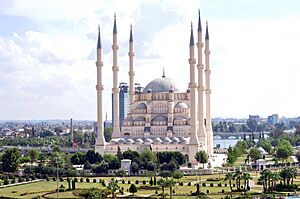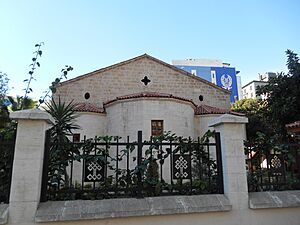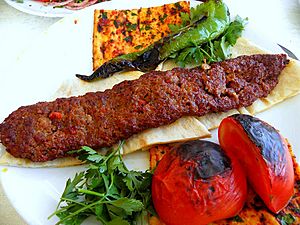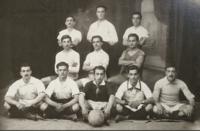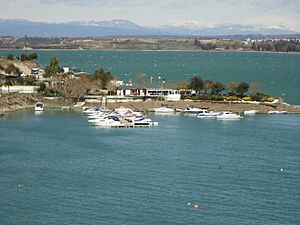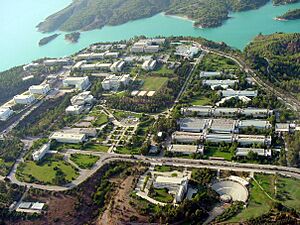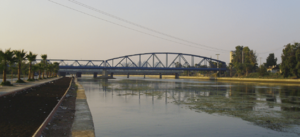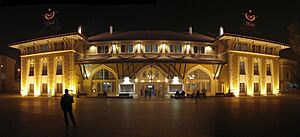Adana facts for kids
Quick facts for kids
Adana
|
||
|---|---|---|
|
Clockwise from top: aerial view over Adana; Stone Bridge; Adana Grand Mosque; Merkez Park; and Adana Clock Tower
|
||
|
||
| Country | ||
| Region | Mediterranean | |
| Province | Adana | |
| Founded | 6000 BC (8025 years ago) | |
| Incorporated | 1871 (154 years ago) | |
| Districts | Seyhan, Yüreğir, Çukurova, Sarıçam | |
| Government | ||
| • Type | Mayor-council government | |
| • Body | Adana Metropolitan Municipality | |
| Area | ||
| • Urban | 2,280 km2 (880 sq mi) | |
| Elevation | 23 m (75 ft) | |
| Population
(end 2022)
|
||
| • Urban | 1,810,646 | |
| • Urban density | 794.1/km2 (2,057/sq mi) | |
| Time zone | UTC+3 (TRT) | |
| Postal code |
01xxx
|
|
| Area code(s) | 0322 | |
| Licence plate | 01 | |
Adana is a big city in southern Turkey. It sits on the Seyhan River, about 35 kilometers (21 miles) inland from the Mediterranean Sea. Adana is the main city of the Adana region. It has a population of about 1.8 million people, making it the largest city in the Mediterranean Region of Turkey.
Adana is in the middle of a historical area called Cilicia. This area was very important in ancient times. Today, Cilicia is home to six million people and is a major farming area, thanks to its large, fertile plain called Çukurova.
Today, Adana is a busy center for trade, healthcare, and many public and private services. Farming and logistics (moving goods) are also big parts of its economy.
You can travel to nearby cities like Tarsus and Mersin by train using TCDD services. The closest public airport is Çukurova International Airport.
Contents
What's in a Name?
The name Adana has been used for over 4,000 years, making it one of the oldest city names still in use! It was first mentioned in ancient Hittite writings around 2000 BC. Even though different groups have ruled the city, its name has changed very little.
One idea is that the name "Adana" comes from an old European word meaning "on the river." This is similar to the names of other rivers like the Danube and Don.
Another story from Greek and Roman legends says that Adana was named after Adanus, the son of the Greek god Uranus. He supposedly founded the city by the river with his brother Sarus, who gave his name to the river. An even older legend, from ancient Akkadian, Sumerian, Babylonian, Assyrian, and Hittite myths, says the name comes from Adad, the god of storms and rain. People in the area admired this god and called the region "Adana Region" in his honor.
In the famous Greek poem Iliad by Homer, the city is also called Adana. For a short time, it was known as "Antioch of Cilicia" or "Antioch on the Sarus." Some ancient clay tablets call the city Quwê.
Under Armenian rule, the city was known as Ատանա (Adana) or Ադանա (Atana). Later, during the Ottoman period, some sources called it Edene, Azana, and Batana.
Adana's Long History
Adana is thought to be the oldest city in Cilicia, with a history stretching back 8,000 years! This makes it one of the longest continuously inhabited cities in the world. The oldest signs of human settlement, found at a place called Tepebağ, date back to around 6000 BC. The city of Adana is even mentioned in the ancient Sumerian story, the Epic of Gilgamesh.
The first known people to live in Adana were the Luwians, from about 3000 BC to 1600 BC. Then, the Hittites took over. Later, around 1190 BC, local "sea peoples" called Denyen controlled Adana. After that, new Hittite states formed, with the Quwê state centered in Adana.
Around 612 BC, the Kingdom of Cilicia was founded. It was independent for a while before becoming part of the Achaemenid Empire (Persian Empire) in 549 BC.
Alexander the Great arrived in Cilicia in 333 BC. After he defeated the Persians, the region became part of the Hellenistic world, and Greek became the main language. The Seleucid Empire then ruled Adana for over 200 years. Later, in 83 BC, Adana became a part of the Kingdom of Armenia.
Roman and Byzantine Times

The Roman general Pompey took control of Cilicia in 64 BC, making it a Roman province. Adana was not as important as some other cities then, but a bridge over the Sarus River (now Taşköprü) was built in the early 2nd century. This bridge made Adana a key stop on a Roman military road to the East.
After the Roman Empire split in 395 AD, Adana became part of the Byzantine Empire. During this time, Adana and Cilicia grew a lot, with new bridges, roads, and buildings, becoming important trade centers.
Byzantine and Islamic Rivalry
In 704 AD, the Umayyad Caliphate (an Islamic empire) conquered Adana. For a long time, Cilicia was a border area between the Byzantine Christian and Arab Muslim forces. In 746, the Byzantines briefly took Adana back, but the Abbasid Caliphate gained control in 756. Under Abbasid rule, Muslims began to settle in Cilicia.
Adana was rebuilt and settled again between 758 and 760. The city grew quickly during the rule of Harun al-Rashid. The Byzantines took Adana back in 965.
Armenian Kingdom of Cilicia
In 1084, Suleiman ibn Qutulmish, who founded the Anatolian Seljuk Sultanate, took Adana. During the Crusades, Adana was captured by the forces of the Armenian Principality of Cilicia in 1132. The Byzantines briefly retook it, but the Armenians gained control again around 1170. During the Armenian period, Adana was a busy center for crafts and international trade.
In 1268, a big earthquake destroyed much of the city. Later, in 1348, the Black Death (a terrible disease) caused many people to die. Adana remained part of the Armenian Kingdom of Cilicia until 1359.
Ramadanid Emirate
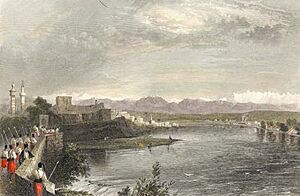
After 1359, the Mamluk Sultanate took control of the plain of Adana. They left the city's management to the Yüreğir Turks, who formed the Ramadanid Emirate in 1352. The leader, Ramazan Bey, made Adana his capital. The Ramadanid Emirate was mostly independent throughout the 1400s. In 1517, the Ottoman Empire took over the area.
Ottoman and Egyptian Eras
The Ottomans took direct control of Adana in 1608. In 1832, Muhammad Ali Pasha from Egypt invaded the region. During this time, Adana Castle and the city walls were taken down in 1836. New canals for irrigation and a water system for the town were built. In 1840, Cilicia returned to Ottoman rule.
The American Civil War in 1861 stopped cotton from reaching Europe. This made European traders look to Cilicia, and Adana became a major center for cotton trade, growing into one of the richest Ottoman cities. The Adana–Mersin railway line opened in 1886, connecting Adana to international ports.
By the early 1900s, Adana's population grew to over 107,000 people, including Muslims (Turks, Alawites, Circassians, Kurds), Armenians, Greeks, Chaldeans, Assyrians, Arab Christians, and others.
A Difficult Time in 1909
In April 1909, Adana experienced a very difficult period. Tensions rose in the city, leading to clashes between different groups. This resulted in many people losing their lives and much destruction, especially in Christian neighborhoods.
After these events, new leaders were appointed to help the city recover. Efforts were made to rebuild damaged areas and support those affected. A new neighborhood was even founded for Armenians, and orphanages were built.
The Berlin–Baghdad railway section in Cilicia opened in 1912, connecting Adana to the Middle East. The city began to recover quickly.
French Rule
After World War I, in 1918, France took control of Cilicia, including Adana. French forces, along with Armenian soldiers, arrived to help Armenians return to Cilicia. There were hopes for an independent "State of Cilicia." Churches, schools, and businesses reopened.
However, French forces were spread thin, and villages faced attacks. The French eventually decided to leave Cilicia. In 1921, the Treaty of Ankara was signed, and France agreed to withdraw. Many Armenians who were not happy with the new situation left Adana and moved to other countries. French troops left the city on January 5, 1922.
Many local Greeks also moved to Greece. Armenians who settled in Lebanon founded a neighborhood called Nor Adana (New Adana). Many Cilician Armenians also moved to Argentina.
Modern Turkey
In 1923, the Turkish government passed a law that took over properties of Armenians and Greeks who were not present in the area. Adana gained a lot of these properties. New immigrants from the Balkans, Crete, and other parts of Turkey were settled in the former Armenian and Greek neighborhoods. This changed the city's population a lot, making it mostly Muslim and Turkish.
On June 27, 1998, a 6.2 magnitude earthquake hit Adana, causing deaths, injuries, and homelessness. The city was also affected by a major 7.8 magnitude earthquake on February 6, 2023.
Adana's Location
Adana is located in the northeastern part of the Mediterranean region. It sits in the middle of the Cilician plain, which is a large, flat, and fertile area southeast of the Taurus Mountains.
The Seyhan River flows through Adana, dividing it into two main parts. This river is very important for the city's fertile soil. It used to cause floods, but dams built in the 1900s, like the Seyhan Dam (completed in 1956), helped control the water and provide power and irrigation.
To the west of Adana, the path to Tarsus goes through the foothills of the Taurus Mountains. It eventually reaches the Cilician Gates, a rocky mountain pass that is a main route into central Turkey.
Weather in Adana
Adana has a hot-summer Mediterranean climate. This means winters are mild and wet, with occasional frost but very rare snow. Summers are long, very hot, humid, and dry. During heatwaves, temperatures often reach or go above 40°C (104°F). The highest temperature ever recorded was 45.7°C (114.3°F) on August 13, 2023. The lowest was -8.1°C (17.4°F) on January 20, 1964.
| Climate data for Adana (1991–2020, extremes 1929-2023) | |||||||||||||
|---|---|---|---|---|---|---|---|---|---|---|---|---|---|
| Month | Jan | Feb | Mar | Apr | May | Jun | Jul | Aug | Sep | Oct | Nov | Dec | Year |
| Record high °C (°F) | 26.5 (79.7) |
28.5 (83.3) |
32.0 (89.6) |
37.5 (99.5) |
41.3 (106.3) |
42.8 (109.0) |
44.4 (111.9) |
45.7 (114.3) |
45.1 (113.2) |
41.5 (106.7) |
34.3 (93.7) |
30.8 (87.4) |
45.7 (114.3) |
| Mean daily maximum °C (°F) | 15.0 (59.0) |
16.6 (61.9) |
19.9 (67.8) |
24.1 (75.4) |
28.4 (83.1) |
31.7 (89.1) |
33.9 (93.0) |
34.9 (94.8) |
33.2 (91.8) |
29.5 (85.1) |
22.6 (72.7) |
16.8 (62.2) |
25.6 (78.1) |
| Daily mean °C (°F) | 9.5 (49.1) |
10.7 (51.3) |
13.9 (57.0) |
17.7 (63.9) |
22.1 (71.8) |
25.9 (78.6) |
28.6 (83.5) |
29.2 (84.6) |
26.6 (79.9) |
22.4 (72.3) |
15.8 (60.4) |
11.1 (52.0) |
19.5 (67.1) |
| Mean daily minimum °C (°F) | 5.6 (42.1) |
6.3 (43.3) |
8.9 (48.0) |
12.4 (54.3) |
16.6 (61.9) |
20.8 (69.4) |
24.3 (75.7) |
24.7 (76.5) |
21.4 (70.5) |
16.9 (62.4) |
11.0 (51.8) |
7.3 (45.1) |
14.7 (58.5) |
| Record low °C (°F) | −8.1 (17.4) |
−6.6 (20.1) |
−4.9 (23.2) |
−1.3 (29.7) |
5.6 (42.1) |
9.2 (48.6) |
13.2 (55.8) |
14.8 (58.6) |
9.3 (48.7) |
3.5 (38.3) |
−4.3 (24.3) |
−4.4 (24.1) |
−8.1 (17.4) |
| Average precipitation mm (inches) | 111.1 (4.37) |
81.9 (3.22) |
59.2 (2.33) |
51.2 (2.02) |
48.2 (1.90) |
20.3 (0.80) |
12.3 (0.48) |
10.4 (0.41) |
25.1 (0.99) |
39.7 (1.56) |
78.4 (3.09) |
143.0 (5.63) |
680.8 (26.80) |
| Average precipitation days | 10.00 | 9.63 | 9.13 | 9.00 | 6.83 | 2.77 | 1.20 | 0.83 | 2.87 | 5.43 | 6.77 | 10.03 | 74.5 |
| Average relative humidity (%) | 67.9 | 66.2 | 65.7 | 66.7 | 66.7 | 68.2 | 71.4 | 70.7 | 65.3 | 61.4 | 63.3 | 69.1 | 66.9 |
| Mean monthly sunshine hours | 139.5 | 144.1 | 186.0 | 213.0 | 282.1 | 318.0 | 334.8 | 322.4 | 270.0 | 229.4 | 177.0 | 136.4 | 2,752.7 |
| Mean daily sunshine hours | 4.3 | 5.1 | 5.9 | 6.9 | 8.6 | 9.9 | 10.1 | 9.4 | 8.7 | 7.2 | 5.7 | 4.0 | 7.2 |
| Source 1: Turkish State Meteorological Service | |||||||||||||
| Source 2: NOAA (humidity, 1991-2020) | |||||||||||||
How Adana is Governed
Adana is governed by several levels of government: national, provincial, metropolitan, and district. The main power comes from the Government of Turkey in Ankara, which manages health, education, and police services.
The city also has a two-part local government: the Metropolitan Municipality and the district municipalities. The Metropolitan Municipality handles big projects like major roads, parks, and fire services. The district municipalities take care of local streets, smaller parks, and garbage collection. These districts are further divided into neighborhoods, each with a local headman called a muhtar.
Metropolitan Municipality
Adana's city government started in 1871. Modern city management began with mayors like Kirkor Bezdikyan, who helped widen roads and build drainage systems. After Turkey became a republic in 1923, many new buildings and planned neighborhoods were created.
When the Seyhan Dam was finished in 1956, Adana grew very fast. The prime minister at the time, Adnan Menderes, helped start big projects like underground sewer systems. Since 1984, the city has changed a lot, with new parks and wide boulevards along the Seyhan River.
In 1989, the city government was split into the Metropolitan Municipality and district municipalities. Adana became a Metropolitan Municipality, and new districts like Seyhan and Yüreğir were formed. Later, Çukurova and Sarıçam districts were added.
The Metropolitan Municipality has a council, a mayor, and an executive committee. The mayor is chosen directly by voters.
City Districts
The city of Adana includes four main districts: Seyhan, Yüreğir, Çukurova, and Sarıçam.
- Seyhan district, on the west side of the Seyhan River, is the city's cultural and business heart. The northern part of Seyhan is the most developed, with hotels, cultural centers, and shops. The Old Town, south of the main road, has a mix of traditional and modern stores.
- Çukurova district is a modern living area north of Seyhan. It was planned in the 1980s to help the city grow. It has many new homes, including villas and tall apartment buildings.
- Yüreğir district, on the east side of the river, has many large factories and residential areas. New bridges and a metro line have made Yüreğir more important.
- Sarıçam is north and east of Yüreğir. It includes places like Çukurova University, the Incirlik Air Base, and the main industrial area.
There are 254 neighborhoods in Adana. Some are very old, like Tepebağ and Kuruköprü. Newer neighborhoods like Reşatbey and Cemalpaşa are important for the city's cultural life.
Adana's Economy
Adana was a major center for growing cotton and grain during the Ottoman period. It was one of Turkey's first cities to become industrial, and today it is one of the most economically developed. In the mid-1800s, European traders came to Adana for cotton when the American Civil War affected their supply. This helped farmers in Cilicia earn money.
By the early 1900s, many factories, mostly for processing cotton, started operating. After Turkey became a republic, more factories opened. The Seyhan Dam and better farming methods led to a huge increase in farm production in the 1950s. Large factories grew along the main roads, and service industries like banking also developed.
However, in the 1990s, many Adana-based companies moved their main offices to Istanbul. This, along with less cotton farming, caused some factories to close. Many young professionals left the city. But now, Adana's economy is starting to grow again, with new investments in tourism, services, and retail. The city is becoming an important regional center once more.
Foreign Direct Investment magazine even named Adana one of the top 25 "European Regions of the Future" in 2006/2007.
Business and Trade
Adana is a leading business center in southern Turkey. It has the regional offices for many companies and public organizations. The TÜYAP Exhibition and Congress Center hosts trade fairs and business meetings.
The Adana Chamber of Commerce (ATO) was founded in 1894 to help with the cotton trade. Today, it has over 25,000 member companies and supports local businesses. The Adana Commodity Exchange, founded in 1913, helps organize trade in farm products and livestock.
New hotels are being built in Adana, including Hilton, Sheraton, and Ramada, showing growth in the tourism and service industries.
Farming
Adana is a key center for farming in the Çukurova region. Lots of cotton, wheat, corn, soybeans, barley, grapes, and citrus fruits are grown here. Adana's farmers produce half of Turkey's corn and soybeans, and a large portion of its peanuts and oranges. Many farming companies have offices in Adana.
The Adana Agriculture Fair is the biggest fair in the region, attracting over 100,000 visitors from many countries. It showcases businesses related to farming, livestock, and dairy.
Factories
Adana's large factories mostly focus on agriculture. Food processing and making metal products are big industries, making up 27% of Adana's manufacturing. There are also many furniture and plastic product factories. As of 2008, eleven companies in Adana were among Turkey's top 500 industrial firms.
Temsa Global, a car manufacturer, is the largest company in Adana, with over 2,500 employees. They make 4,000 buses each year. Advansa Sasa is Europe's largest polyester maker. The Organised Industrial Region of Adana has 300 factories.
People of Adana
As of late 2022, the total population of Adana's four main districts was about 1,810,646 people. Most of Adana's residents live west of the Seyhan River, where the city first started.
Historically, Adana has been home to many different groups of people. In the 17th century, it had Turkomans, Arabs, Greeks, Armenians, and Jews. Over time, more Armenians and Greeks settled in the city.
In the 1990s, the city's population changed a lot due to many Kurds moving from southeastern Turkey. There are also communities of Romani people and migrants from the Balkans and Caucasus.
Adana is home to a mix of people with different beliefs. Most Turks, Kurds, and some Arabs are Sunni Muslim. Adana also has many Alevis and Alawites (who are sometimes confused with Alevis). There are also small communities of Roman Catholics and Jewish families.
Adana also hosts about 2,000 British and Americans who work at NATO's Incirlik Air Base.
Fun Things to See and Do
Old Buildings
The oldest signs of settlement in Adana are in the Tepebağ area, dating back to the Stone Age. This area is next to the Taşköprü (Stone Bridge). The city is working to protect the old Ottoman houses near the river. A house where Atatürk stayed is now the Atatürk Museum.
Adana's best time for architecture was in the late 1400s and 1500s when the Ramadanid rulers made it their capital. Many historical buildings were built then, showing Mamluk and Seljuk styles. The Taşköprü is the only remaining Roman-Byzantine building.
Mosques
The Ulu Cami, built in 1541, is Adana's most interesting old mosque. It has a school (medrese) and a tomb (türbe). The mosque is made of black and white marble and has beautiful 16th-century tiles inside.
The Yağ Camii was first a church, then became a mosque in 1501. It has a tall minaret and a beautiful yellow stone gate. The Yeni Camii (New Mosque) was built in 1724 and has interesting stonework.
The huge Sabancı Merkez Camii (Sabancı Central Mosque) on the Seyhan River is Adana's most visited mosque and one of the largest in the Middle East. It opened in 1998 and can hold up to 28,500 people. It has six tall minarets and a large dome, making it visible from far away.
Museums and Art Galleries
Adana Archaeological Museum opened in 1924 as one of Turkey's first museums. It has ancient items from all over the Çukurova region. You can see statues, a sarcophagus showing the Trojan War, and mosaics.
Adana Ethnography Museum opened in 1983 in a former church. It shows old clothes, jewelry, and weapons from nomadic villagers.
The Atatürk Museum tells the story of Turkey's War of Independence and the early years of the Republic.
Other museums include the Karacaoğlan Museum of Literature and the Adana Museum of Cinema. The State Fine Arts Gallery and other public galleries show local art.
Bridges
The most famous bridge in Adana is the Taşköprü, a Roman bridge from the 2nd century. It's now used by people walking and cycling. Until 2007, it was the oldest bridge in the world still open to cars! The Demirköprü is a railway bridge built in 1912. There are also other road bridges and footbridges across the Seyhan River.
Turkish Baths (Hamams)
The Çarşı Hamam (Turkish bath of the Bazaar) was built in 1529 and is Adana's largest traditional bath. It has five domes and marble inside. The Irmak Hamam (Turkish bath of the River) was built in 1494 over old Roman bath ruins.
Churches
In the 1800s, Adana had four churches. The Roman Catholic Saint Paul Church (Bebekli Kilise) was built in 1870 and is still used today. The Agios Nikolaos (St Nicholas) Greek Orthodox Church, built in 1845, was turned into a museum but became a church again in 2015.
Parks and Gardens
Adana has many parks and gardens, open all year because of the warm weather.
Paths along both sides of the Seyhan River run through the city, connecting to the Seyhan Reservoir. The most beautiful part is Dilberler Sekisi on the west bank.
The Merkez Park (Central Park) is a huge 33-hectare park on both sides of the Seyhan River. It has an amphitheater, a Chinese Garden, and cafes, making it a main place for fun.
The Süleyman Demirel Arboretum is a large botanical garden with many different kinds of trees and plants. It's used for scientific study and for people to relax.
Atatürk Park is a city park in the center, with a statue of Atatürk. Çobandede Park is on a hill overlooking the Seyhan Reservoir.
Other Attractions
The Büyük Saat (Great Clock Tower), built in 1882, is Turkey's tallest clock tower, standing 32 meters (105 feet) high. Its image is on the city's coat of arms. The Kazancılar Çarşısı (Cauldron-makers Bazaar) is a market area around the clock tower.
Ramazanoğlu Hall was built in 1495 and is one of the oldest surviving houses in Turkey.
Food and Fun
Delicious Food
Adana's food is a mix of local, Arabic, and Armenian cooking. Dishes are often spicy, sour, and made with meat (usually lamb) and bulgur (cracked wheat).
The Adana kebabı is the most famous dish. It's made from minced meat and is so popular that its name is known worldwide. Adana kebab is usually served with onion salad, green salad, or chopped tomato salad. People often drink şalgam (turnip juice) with it.
Other local favorites include Şırdan, a sausage stuffed with rice, and bicibici, a sweet dessert made from jellied starch, rose water, and sugar, served with crushed ice.
Arts and Entertainment
The Çukurova State Symphony Orchestra performs regularly from October to May. The Adana State Theatre also has regular shows. The Adana Town Theatre has been performing since 1880.
Several outdoor amphitheaters host concerts and movies from April to November. The Mimar Sinan Amphitheatre is the largest, holding 8,000 people.
The Altın Koza International Film Festival is one of Turkey's most important film festivals, held since 1969. The International Sabancı Theatre Festival takes place every April.
An Orange Blossom Carnival is held every April, celebrating the scent of the city's orange trees. In 2015, over 90,000 people attended the carnival parade!
The World Rakı Festival, now officially called the Adana Kebab and Şalgam Festival, is held in December. It's a big food festival where people enjoy kebab, liver, and traditional drinks with street music.
Sports
Sports have been popular in Adana for a long time. The first sports clubs were founded by the Armenian community in the early 1900s.
Football is the most popular sport. Adana has two main professional football clubs: Adanaspor and Adana Demirspor. They both play at the New Adana Stadium. Matches between them are known as the Adana derby, creating a big rivalry.
Basketball, volleyball, and handball are also played professionally. The warm weather makes Adana great for water sports like rowing, sailing, swimming, and water polo. The Adana Demirspor water polo team is famous for winning many championships.
Rowing and sailing competitions happen all year on the Seyhan River and Seyhan Reservoir. The Adana Half Marathon is a running race held every January, following the city's historic streets.
Horse racing is also very popular. The Adana Yeşiloba Hippodrome hosts horse races from October to May.
Daily Life in Adana
Media
Adana has several daily newspapers, like Yeni Adana and Ekspres. Many national newspapers also have regional sections published in Adana. Local TV channels include Kanal A and Çukurova TV. There are also many local radio stations.
Shopping
Çakmak Street is a traditional shopping area in the old town. There are also historical markets around the Büyük Saat (Clocktower) and Yağ Camii (Oil Mosque).
Ziyapaşa Boulevard is a fancy street with expensive brand-name shops. Other high-end shops are found in northern Adana, especially along Özal, Demirel, and Evren boulevards.
Adana has four modern shopping malls: Galleria, M1, Carrefour, and Optimum Outlet. Optimum Outlet is the newest and offers views of the river and Merkez Park.
Learning in Adana
Schools
Adana has many public and private schools for students from elementary to high school. The city also has schools for students with special needs and centers for adults to learn new skills.
Libraries
The Ramazanoğlu Library, founded in 1923, is now called the Adana Public Library. It has a branch in the Karacaoğlan Museum of Literature. The Adana City Library focuses on books and materials about Adana's history and culture.
Fairs
The Çukurova Book Fair is a big event that attracts many visitors and publishers. The Çukurova Education Fair also takes place at the same time, with many educational institutions participating.
Universities
Adana has two state universities and two private universities.
Çukurova University is a state university located by the Seyhan Reservoir. It was founded in 1973 and has many cultural, social, and sports facilities for its 40,000 students.
Adana University for Science and Technology is a newer state university. Çağ University and Kanuni University are private universities.
Healthcare
Adana is an important healthcare center for a large area. It has four university hospitals, eight state hospitals, and seven private hospitals.
Balcalı Hospital, part of Çukurova University, is a large research hospital with many beds for patients. It is one of the biggest hospitals in southern Turkey. A new health campus is also being built in Yüreğir, which will include several specialized hospitals.
Getting Around Adana
Adana is now a key point on the route connecting Europe to the Middle East.
Travel Between Cities
Adana's closest airport is Çukurova International Airport, about 34 km (21 miles) from the city center. It's one of Turkey's busiest airports, with flights to major cities in Germany, London, and other international destinations, as well as many flights within Turkey.
Turkish State Railways (TCDD) has train lines connecting Adana to Ankara, Kayseri, and other cities. There are also regional train lines, including a commuter train to Mersin.
Buses are still a main way to travel to and from Adana. The city has two bus terminals: the Central Bus Terminal for western cities and the Yüreğir Bus Terminal for eastern cities.
Adana is also connected by a large motorway network that reaches many cities in different directions.
Getting Around the City
Local transport in Adana includes the Metro, municipal buses, and minibuses called dolmuş.
The Adana Metro is a rapid transit system that runs for 14 km (9 miles) and has thirteen stations. It can carry many passengers quickly. There are plans for a second metro line in the future.
The city also has many bus services. You can pay for bus rides using a smartcard system called Kentkart. Minibuses (dolmuş) also provide services to smaller streets.
Cycling and Walking
Adana is mostly flat and has warm weather, making it good for cycling and walking all year. While there aren't many dedicated bike lanes, there are some bike paths.
The city has been built more for cars in recent decades, and sometimes sidewalks are used for parking. However, there are plans to make areas like Taşköprü more pedestrian-friendly. Turgut Özal Boulevard is considered one of the most pedestrian-friendly streets.
Adana's Sister Cities
Adana is connected to other cities around the world as "twin towns" or "sister cities." This helps promote cultural exchange and friendship.
|
Europe
|
Asia
|
Images for kids
See Also
 In Spanish: Adana para niños
In Spanish: Adana para niños


